Theory Test Rules of the Road
To learn all about the Rules of the Road category. Watch the video or read the article below.
The theory test featuring questions from this category is at the bottom of the page.
Topics Include
- Speed Limits – Knowing the different speed limits and when to use these speed limits.
- Lighting – using car lighting effectively and safely to see and be seen when driving.
- Lane Discipline – know and understanding lane rule regulations.
- Parking – where to safely park and knowing the different parking restrictions and regulations.
Again, safety is a theme that dominates many questions.
Many questions present every day road situations where the correct answer is always the safest options, for example:
You are on a busy main road and find that you are travelling in the wrong direction. What should you do?
1. Turn into a side road on the right and reverse into the main road
2. Make a U-turn in the main road
3. Make a ‘three-point’ turn in the main road
4. Turn round in a side road
The correct answer, the safest, is 4.
No question will require an answer such as ‘speed up’, ‘sound your horn’ or ‘flash your lights’
Facts to Know
- The national speed limit for cars and motorcycles on single carriageway roads is 60 mph.
- The national speed limit for cars and motorcycles on motorways and dual carriageways is 70 mph.
- The speed limit for cars towing a trailer on single carriageway roads is 50 mph.
- The speed limit for cars towing a small caravan on motorways and dual carriageways is 60 mph.
- On a road with street lights, but no speed limit signs, the speed limit is usually 30 mph.
- At an unmarked crossroads no one has priority.
- The nearest you can park to a junction is 10 metres (32 feet).
- You may drive over a footpath to get to a property.
- You must not drive in a cycle lane marked by a solid white line during its period of operation.
- A cycle lane marked by a broken white line means you should not drive in, or park in the lane unless it is unavoidable.
- You must not drive in a bus lane during its hours of operation. The hours of operation will be marked on the bus lane road sign.
- You must not stop where an urban clearway is in force.
- When waiting at a level crossing if the red lights continue to flash after a train has passed you must continue to wait.
- Never park in an disabled only parking space unless permitted i.e. you are a blue badge holder.
- If a car overtakes you at night and you have your headlights on full beam you should switch them to dipped as soon as the vehicle passes you.
- Zebra Crossing – if someone is waiting to cross you should stop and let them cross.
- Toucan Crossings – can be use by cyclists and pedestrians.
- Pelican Crossings – a flashing amber light means you must give way to pedestrians still crossing. If the light changes to red and people are still crossing then you must continue to wait and let them cross
- You can only drive in a bus lane outside its hours of operation.
- Never reverse for longer than you have to, or from a side road into a main road.
Box Junctions
- You may only wait in a box junction when you’re turning right and your exit lane is clear but you can’t complete the turn because of oncoming traffic. For further information see our box Junctions Video Tutorial.
Parking at Night
- If you park at night on a road where the speed limit is above 30 mph you must leave your parking lights (sidelights) on.
- Always park facing the flow of traffic
Where Not to Park
- On the pavement
- At a bus stop
- In front of someone’s drive
- Opposite a traffic island
- Near a school entrance
- On a pedestrian crossing (or inside the zigzag lines either side of it)
- Near a junction
- On a clearway
- On a motorway
Roundabouts
- Going left – signal left as you approach the roundabout. Keep signalling until you have left the roundabout.
- Going straight ahead – signal left just after you pass the exit before the one you will take.
- Going right – signal right as you approach the roundabout. Signal left just after you pass the exit before the one you will take. Roundabouts Video Tutorial.
- Cyclists and horse riders may stay in the left-hand lane even if they are turning right.
- Long vehicles may take up a different position to stop the rear of the vehicle hitting the kerb.
Reversing
- You must not reverse for longer than is necessary.
- Never reverse from a side road onto a main road
- When reversing into a side road, the main hazard to oncoming traffic, is when the front of your vehicle swings out.
Key Signs
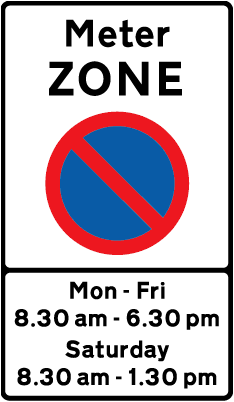
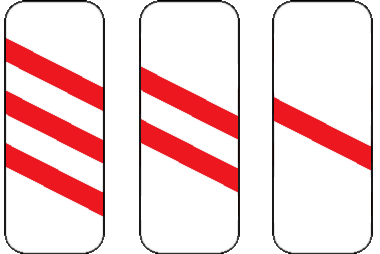
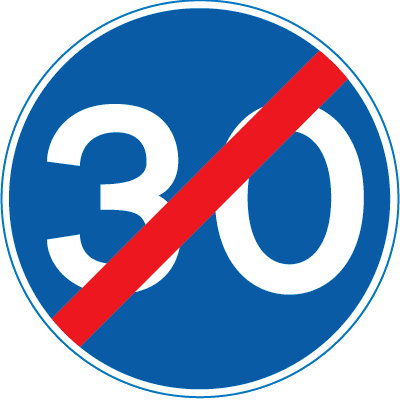
End of minimum speed limit
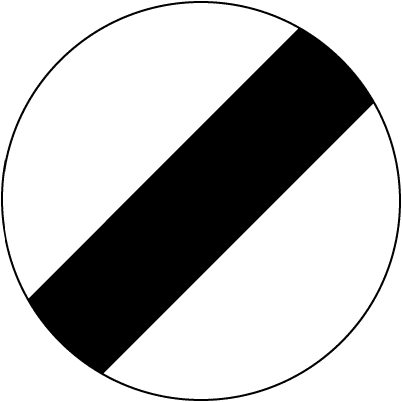
National speed limit applies.
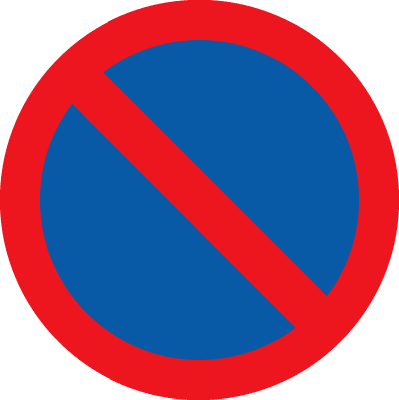
No waiting at any time
